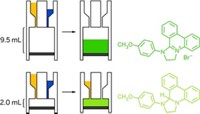Advertisement
Grab your lab coat. Let's get started
Welcome!
Welcome!
Create an account below to get 6 C&EN articles per month, receive newsletters and more - all free.
It seems this is your first time logging in online. Please enter the following information to continue.
As an ACS member you automatically get access to this site. All we need is few more details to create your reading experience.
Not you? Sign in with a different account.
Not you? Sign in with a different account.
ERROR 1
ERROR 1
ERROR 2
ERROR 2
ERROR 2
ERROR 2
ERROR 2
Password and Confirm password must match.
If you have an ACS member number, please enter it here so we can link this account to your membership. (optional)
ERROR 2
ACS values your privacy. By submitting your information, you are gaining access to C&EN and subscribing to our weekly newsletter. We use the information you provide to make your reading experience better, and we will never sell your data to third party members.
Environment
Made in Belgium
March 24, 2008
| A version of this story appeared in
Volume 86, Issue 12
In "Carbon Nanotubes by the Metric Ton," Ann M. Thayer refers to "Soci??t?? Nanocyl" and describes its development with great accuracy (C&EN, Nov. 12, 2007, page 29).
Soci??t?? Nanocyl is a spin-off of both Belgium's University of Namur and University of Liège. These two universities are among Nanocyl's shareholders. This is clearly indicated on the company's website at www.nanocyl.com and www.nanocyl.com/innovation/activities/.
The nuclear magnetic resonance lab of the University of Namur, under the direction of J. B. Nagy, designed the first catalyst able to produce carbon nanotubes (CNT) on a large scale (4 kg CNT/kg catalyst from ethylene).
Researchers in the chemical engineering laboratory of the University of Liège, under my direction, designed and developed, from 1999 to 2002, a 2-kg-per-day prototype continuous reactor. Patents are already delivered in several countries. This is the type of reactor that Nanocyl started up in mid-2005 for 15-kg-per-day production and, in 2007, for an annual capacity of 40 metric tons. Furthermore, in 2006, the same laboratory, still under my direction, designed and developed a new catalyst that makes it possible to achieve very high productivity using natural gas. This new catalyst has been used in the industry since the beginning of 2008.
I must note that the University of Liège is too often left out when Nanocyl is presented in the press. I am all the more dismayed that the present expansion of Nanocyl is mostly the outcome of the work carried at the University of Liège since 1999, whereas the University of Namur is no longer active in that field.
Jean-Paul Pirard
Liège, Belgium





Join the conversation
Contact the reporter
Submit a Letter to the Editor for publication
Engage with us on Twitter